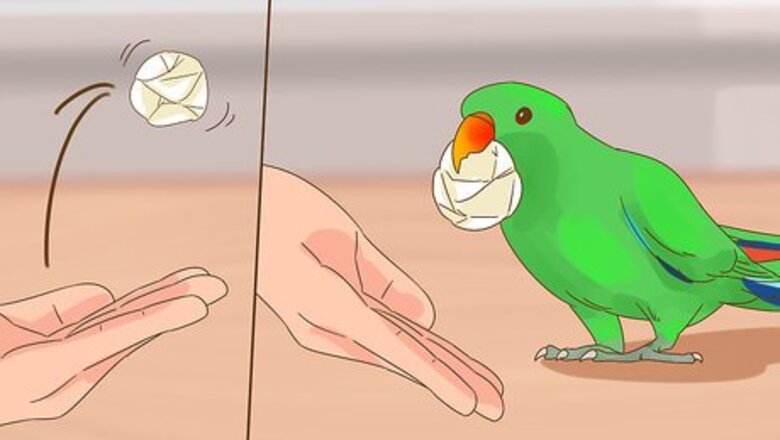
views
Playing Games with Your Parrot
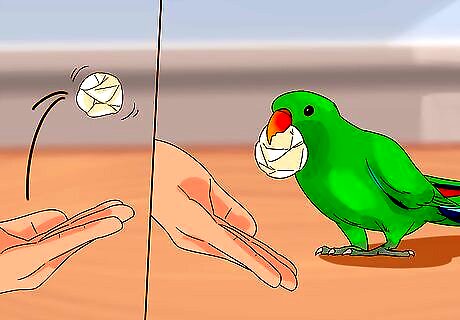
Throw a ball around to play fetch. Wad up a piece of newspaper or get something your parrot can pick up, such as a wiffle ball. Make the ball bigger than your bird’s beak so it can’t be swallowed. To play hold your hand out in front of your parrot and let it retrieve the ball. Then, move away and urge it to bring the toy to you. Offering a treat and praise helps encourage it to come back. Many birds love throwing the ball instead of bringing it back. If you don’t mind getting the exercise, retrieve the ball and give it back. Have a couple of fetch toys, such as plastic keys and a couple of different balls. That way, your bird learns the game without getting bored.
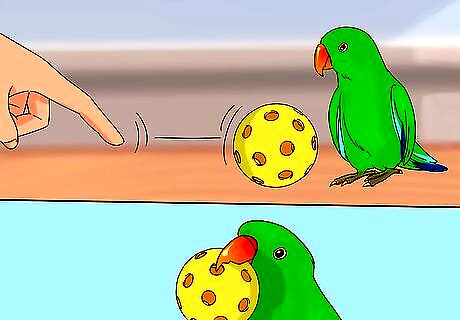
Roll the ball to your bird to play catch with it. Set your parrot on a flat surface, then stand opposite it. Gently push a big ball forward and wait for your bird to pick it. Retrieve the ball to continue playing. Giving your parrot a treat will convince it to let go if it tries to keep the ball. Choose a ball that your bird can handle without swallowing. Big wiffle balls or squeezable balls are often great choices for large parrots. Large wads of paper also work well. Roll the ball gently towards your parrot so you don’t scare it!
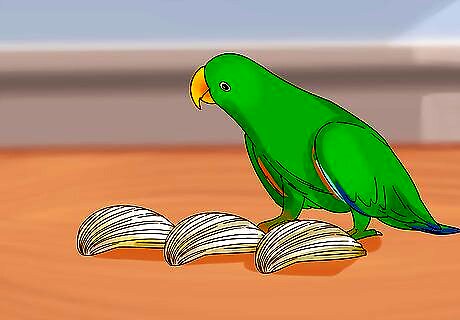
Play the shell game to give your parrot a fun treat. Pick out 3 large “shells” and your bird’s favorite treat. Paper cups are a great substitute if you don't have actual shells big enough for your bird to easily move without crushing them. Put the treat under 1 of the shells, then shuffle all of the shells together. Wait for your parrot to pick a shell. Even if it picks the wrong shell, let it have the treat. Healthy treats for parrots include small pieces of mango or papaya, apple slices, seedless grapes, carrots, leafy vegetables, grains, and tiny bits of walnuts or almonds. Avoid offering peanuts or sunflower seeds. You can give your parrot peanut butter, but note that it's high in fat and should only be given as an occasional treat.
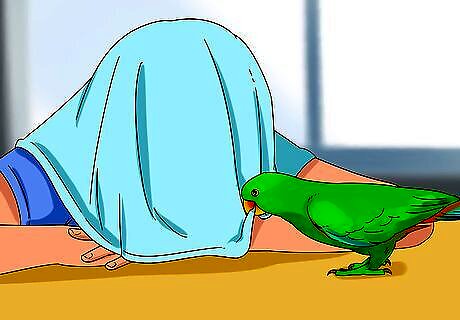
Use a towel to play hide and seek with your parrot. Take your parrot to a tabletop, bed, or another safe area. Fold your arms, put your head down, then drape a big, fluffy bath towel over your head. Many parrots can’t resist running up and taking a peek under the towel. If your parrot doesn’t react, call it to get its attention and give it a treat when it comes near the towel. Also, try playing by draping the towel over your parrot. Be gentle, and, if your parrot doesn’t like being covered, remove the towel right away.
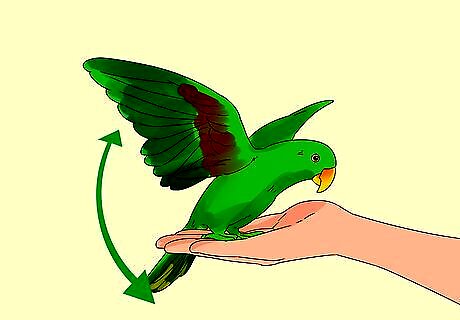
Exercise your parrot by flapping with it. Let your parrot step up onto your arm or hand, then gently move your hand up and down or swoop around in figure eights. Watch for your parrot to flap their wings as you move it through the air. Stop and give the parrot a break when it starts breathing hard. Give it a treat when it steps up and rests on your hand to encourage it to stay there. This can be done while your parrot is on your shoulder or on another surface. Flap your “wings” to get your parrot to join in! Vary up the game by dancing. Many parrots love dancing along with their owners. Play some music to accompany your moves.

Chase your parrot for another way to get it active. Take your parrot to a flat, safe surface such as a bed or tabletop. Wiggle your fingers and move them towards your pet. Many times, it will turn and run away. Big parrots are easy to follow, but they move pretty quickly! When you catch it, tickle it with your fingers or give it a treat to let it know it’s playing the game correctly. This game is startling to some parrots, so avoid it if yours is scared. Choose something a little slower, like fetch or catch. Be aware of your positioning. Slow down when your bird approaches the edges of a surface. If you’re playing on the floor, avoid running after your bird.
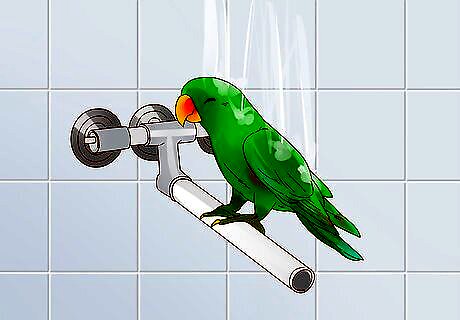
Take your parrot into the bathroom while you groom yourself. Parrots find activities like brushing your teeth to be fascinating. They like watching their owners brush their hair, for instance, and may even try to help. In addition, most parrots enjoy showers, so try bringing your pet into the shower with you (but make sure the water is warm). Expect lots of happy noises and silly dances while your parrot gets wet. If your parrot is nervous at first, give it treats while it’s in the bathroom or shower. Showers are healthy for birds and not very different from what they experience in the wild. Since large parrots like macaws are very heavy, you may need to have a stable surface or door available unless you can carefully balance the bird on your shoulder. Many pet supply stores sell suction cup stands that stick to smooth surfaces like bathroom walls. Get a big perch with multiple suction cups to better accommodate the weight of a large parrot. If you don’t wish to bring your parrot into the shower, fill a spray bottle with warm water, put it on a fine setting, and gently mist your bird 2 or 3 times a week. Keep it warm afterward, especially during the winter. Test the strength of the mist by misting your own face. Also, use a pump spray bottle rather than one with a trigger.

Create a big foraging box for your parrot to play in. Get a large but shallow cardboard box, then fill it with toys. Adapt household waste like plastic bottle caps for some inexpensive chewable toys. Add in items like wads of newspapers for your bird to tear up. Include other things your bird likes, such as rope, large rocks, and nuts. If your parrot won’t get in, start giving it treats as soon as it approaches the box to encourage it. Use this option with caution as your parrot may think the box is a nest, which can lead to territorial behavior or feather destruction. To join in on the fun, get a kitchen implement like a big soup ladle and tap the side of the box to get your parrot’s attention. Keep tapping it against the box as you bring it closer to their view. Clean toys thoroughly with soap and water before giving them to your parrot. Items like used plastic often contain bacteria, leftover food, or drinks that aren’t healthy for birds.
Teaching a Nervous Bird to Play
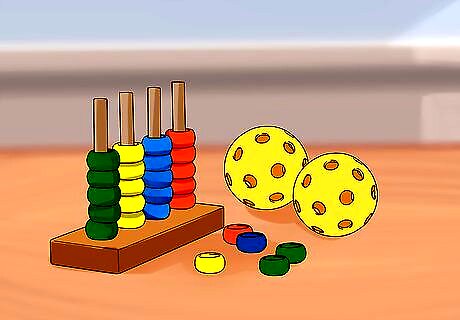
Get a toy that your parrot isn’t afraid of. Pick out something that makes your bird curious. If you’re unsure, watch it while they’re in its cage. Note which toys they go to, then get a similar one or take the toy out during playtime. Large parrots are often most comfortable around familiar objects made from wood or paper. If you don’t have a good toy to use, try placing a ball on a stick. Hold it close to you. Let your parrot observe it from afar.
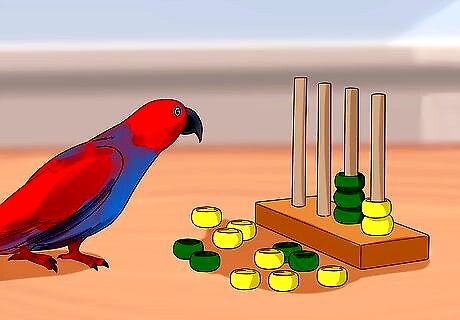
Show the parrot the toy and wait for it to approach it. Stand away from your parrot with the toy. Be patient and let it come to you. If it opens its beak before it gets close, step back to avoid that big, powerful beak. Your parrot may be afraid at first, but with repeated exposure, it will eventually feel safe enough to come explore. Give your bird plenty of room to move. Put it on a large playstand or surface if you can. If the parrot doesn’t let you touch it, leave the cage open and stand nearby.
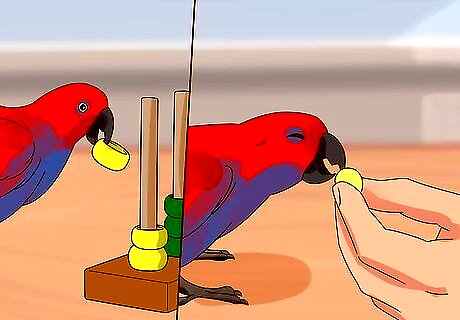
Offer your parrot praise and a treat when it approaches the toy. Say something like “good boy,” then hold out your hand with your bird’s favorite treat. If your bird is afraid of toys, at first you will need to praise it when it approaches. Go slowly so your feathered friend understands that the toy is safe to touch. Many fruits, vegetables, nuts, and grains are safe and healthy treats for parrots. Avoid things like seeds, pits, avocados, dried beans, and onions. Rewarding your parrot for positive behavior is much more effective than punishing it for bites and other negative behaviors.
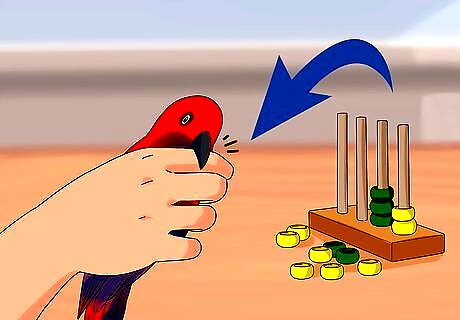
Put the parrot away and wait if it bites you. Reacting to a bite is tempting, but doing something like spraying the bird with water or flicking its beak doesn’t help. Your parrot will remember a negative experience and become more likely to try and take a bite out of you with its big beak. If you need time to calm down, put the parrot back in its cage, then come back to play when you’re ready. Large parrots freeze in place, click their beaks, or hiss when they’re unhappy. Be cautious, especially when bringing a parrot into a new environment. Avoid attempting to play while wearing a glove. Your parrot may be afraid of the glove. If they adapt to the glove, they will then be afraid of your hand when you take the glove off.
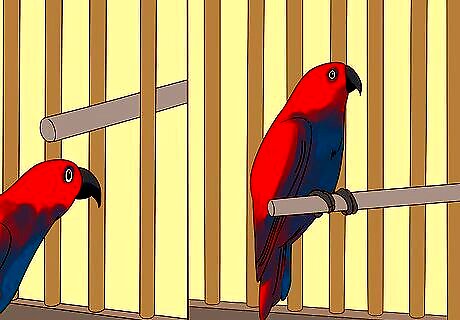
Play the laddering game if your parrot is too afraid to approach you. For the laddering game, you need several rough sticks or dowels of different sizes, including a large one that can support your parrot’s weight. Keep the sticks near your parrot’s cage until they get used to their presence. Once it feels safe stepping on the sticks, have it step onto your hand. Then, hold the biggest stick out and let it step up onto it. For very timid birds, go slowly. Keep the sticks in the room for about a week until your pet adjusts to their presence. Then, gradually move the sticks a little closer each day. When laddering with your hand, hold out multiple fingers for your parrot. Alternatively, hold out your palm or arm.

Touch the toy to show your parrot how to play with it. Act like the toy is meant for you. Bat it around a little bit. Get as animated as you need to in order to make it look fun! Your parrot will get curious and soon want to join in. Doing this helps parrots that were never taught to play with toys. If your bird looks curious or approaches a toy without touching it, try swatting the toy around yourself. You can slowly move it toward the enclosure over a series of several days.
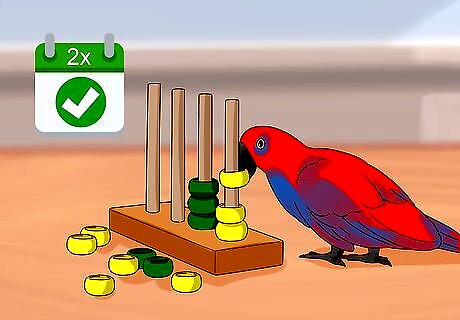
Repeat the play sessions twice a day until your parrot is comfortable. Depending on your parrot, training may take a while. Work slowly and don’t push your parrot when they seem hesitant to respond. Parrots have reasons for their actions, and you may not know what they experienced in the past. As long as you are patient and friendly, your parrot will learn safe ways to play with you. Parrots that were rescued or rehomed, wild-caught, and “breeder” birds may be unused to people and may not have had much time out of their enclosure for enrichment. Or, they may have had negative experiences with past owners. With love, a gentle hand, and a quiet environment, you can get your parrot to adapt.
PIcking a Toy and Play Location
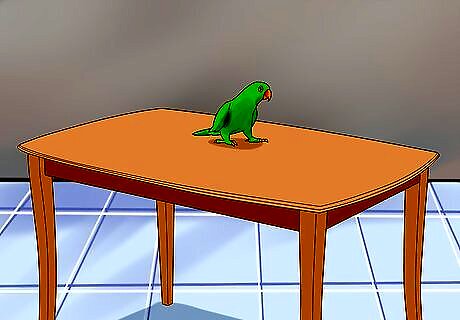
Choose a safe, quiet spot for your parrot to play. Keep your parrot out of harm’s way by picking a spot away from other activity in your home. Large parrots need big, wide surfaces like tabletops, countertops, floors, and beds. Leave enough space for your parrot to move around and explore. If you play on the floor, make sure any other pets you have are in a separate, closed room. Additionally, make sure there are 2 doors between the parrot and the outside world if the bird can fly. Ensure your parrot doesn't have access to fans or other household hazards like open toilets, boiling water, hot stovetops, and so on. Perches are fine on some occasions. Because of the size of large birds, perches often don’t provide enough space for you to join in on games.
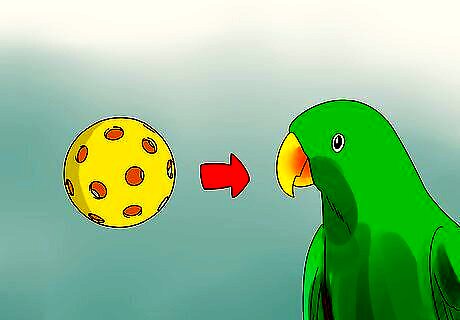
Pick toys that are bigger than your bird’s beak to avoid accidents. Big parrots have the strength to crush toys meant for smaller birds. Splinters are a risk, and then you end up needing to spend more money replacing the broken toy. If you plan on incorporating smaller objects, make sure they’re made of a hard material like metal or plastic. Any toys that you intend on leaving in the parrot’s cage need to be big. Monitor your pet while it plays to make sure the toy is safe. Don’t leave your pet unattended with toys that have small components like screws. These can cause metal toxicity as well as other problems if they are swallowed. If you need a size comparison, visit a pet store and look for toys labeled as large and extra large. Large toys are enough for most big parrots, but extra large toys are more durable for destructive birds.
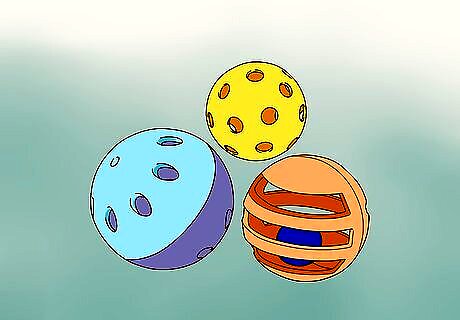
Pick acrylic and plastic toys for durability. Plastic toys are often marketed as indestructible. Since they hold up so well, they are good for rougher games like fetch. Look for plastic balls and other toys your parrot can pick up and chew on. Plastic toys are generally safe to hang in cages, but get strong polycarbonate toys that a big parrot can’t easily break. Plastic toys often aren’t very fun for parrots, so plan on using them in short bursts. If you hang them in your pet’s cage, rotate them out frequently. Metal toys are the same as plastic toys, although they’re even more durable. If you do use metal toys or make your own toys, test them with a magnet to make sure they don't contain harmful elements like zinc.
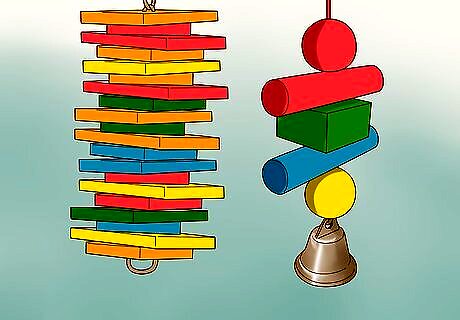
Choose wood toys to hone your parrot’s beak. Your large parrot is bound to make you groan by quickly shredding a new wooden toy. Birds like tearing apart wood and it’s healthy for them. Get some sizable wood toys for use in foraging boxes, cages, and for rougher games. Replacing wood toys gets expensive, so find ways to make your own toys. For instance, weave strips of pine together or get a piece of balsa wood. Put a treat inside it to turn it into a foraging toy. For more info on making foraging toys, see https://www.avianstudios.com/captive-foraging-dvd/.
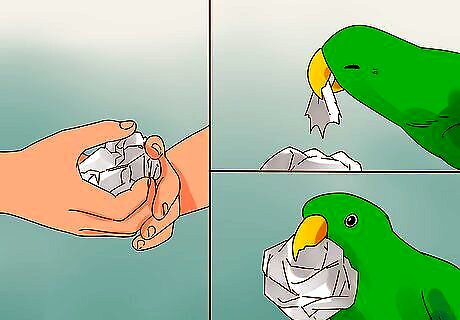
Crumple up papers to create balls for your parrot to shred and fetch. Paper is a safe alternative to many plastic and wood toys. Roll undyed paper or newspaper into a large ball you can throw or have your bird catch. You can even put a treat inside the ball so the parrot has to forage for it. Paper balls are inexpensive toys for parrots to fling around or tear up when they feel destructive. Parrots rarely swallow paper, but take precautions if you think your parrot eats paper. Don’t leave it sitting around for your parrot when you’re not around.
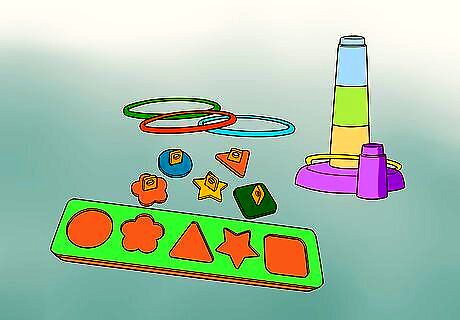
Get puzzle toys to stimulate your parrot’s curiosity. Parrots are very intelligent, so they get bored easily. A good puzzle box entertains your parrot by giving it a problem to solve. For example, your parrot may need to spin a gear on the toy to open it and retrieve a treat. Puzzle toys for large birds need to be big and durable. Puzzle toys are often simple to make at home out of wood or plastic boxes. For instance, lock a treat behind the box’s door and let your bird figure out how to open it.
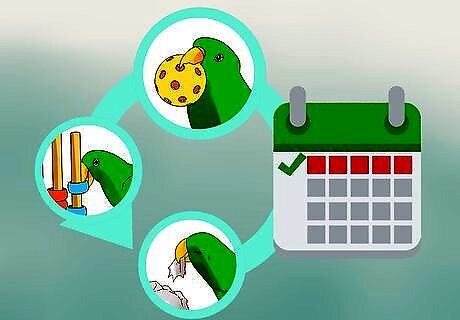
Rotate through toys every week to keep your parrot entertained. Big parrots need lots of stimulation to stay healthy and entertained. Have about 4 to 6 toys for your bird at all times. Put in new toys or arrange them in new combinations, especially if you plan on leaving the toys in the cage all week. That way, your pet always has something new to explore. Consider getting separate toys for your parrot to play with when its out of the cage. For example, get several different fetch toys to keep the game fresh for your pet.














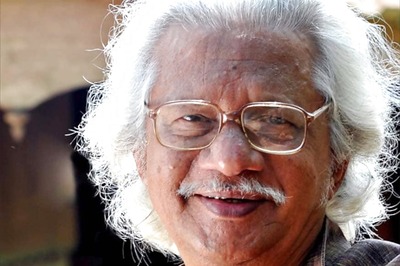





Comments
0 comment